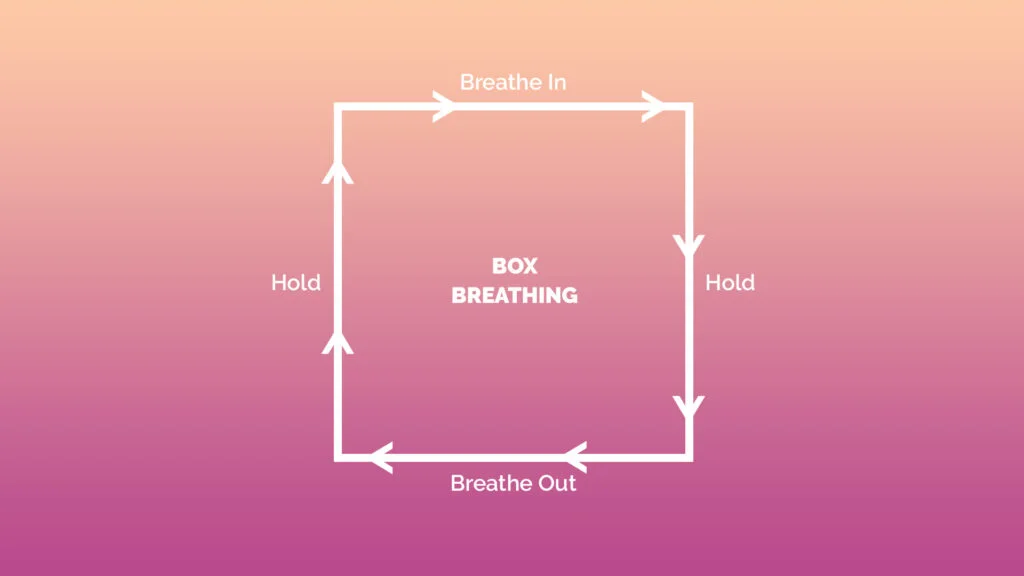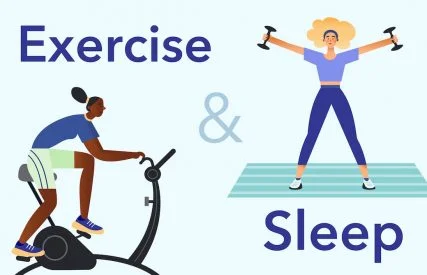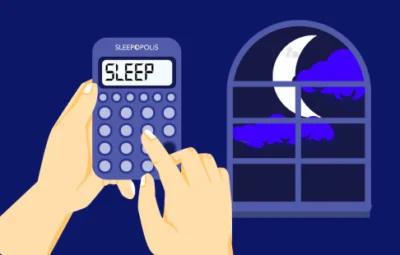
If your mind starts racing just as you’re crawling into bed, box breathing could be the relaxation technique that changes everything. We spoke with two breathing experts for details on this simple but surprisingly powerful method of calming the mind and relaxing the body, including how it might ease you into a better night’s sleep.
The content on Sleepopolis is meant to be informative in nature, but it shouldn’t be taken as medical advice, and it shouldn’t take the place of medical advice and supervision from a trained professional. If you feel you may be suffering from any sleep disorder or medical condition, please see your healthcare provider immediately.
Long Story Short
- Box breathing is a simple but powerful relaxation technique that brings mindfulness to the breath, which can help calm the nervous system.
- Focusing on equal timing for all four parts of the breath—inhale, hold, exhale, hold—can promote relaxation and calmness, helping individuals fall asleep faster and even improve sleep quality.
- Box breathing can be an effective addition to a calming bedtime routine designed to promote better sleep.
What Is Box Breathing?
The act of taking a breath has four parts:
- Inhaling
- Pausing at the top
- Exhaling
- Pausing at the bottom
With box breathing, all four parts have equal timing. “Box breathing follows a pattern of inhaling for four counts, holding for four counts, exhaling for four counts, and holding again for four counts,” Mandy DeVries, RRT, RRT-NPS, respiratory therapist and director of education at the American Association for Respiratory Care (AARC), tells Sleepopolis. “This technique is widely used in yoga and meditation practices and has gained popularity among the general population as a stress-reducing and relaxation technique.”

Additionally, box breathing, also known as four-square breathing or square breathing, is “when we use the mind to control the breathing rhythm,” Edward Dangerfield, a nervous system specialist and the founder of Breathwork Bali, tells Sleepopolis.
This type of cadence breathing is calming because it’s repetitive and gives your brain something to focus on instead of spiraling, which can exacerbate an anxiety or stress response. Studies have linked this type of slow, focused breathing with favorable outcomes, including a greater sense of comfort and relaxation, plus reduced symptoms of anxiety, depression and anger.
The box breathing technique can benefit a wide range of people. According to Dangerfield, box breathing improves the physical mechanics of breath, including capacity, which can positively influence both emotional resilience and the nervous system. For those with specific health concerns, including asthma, chronic obstructive pulmonary disease (COPD), and other respiratory conditions, box breathing can be a helpful way to manage symptoms. “It’s also an effective technique for managing anxiety and promoting mental clarity,” says DeVries.
Do Navy Seals Really Use Box Breathing?
Box breathing is often used in high-stress scenarios by people like police officers, nurses, members of the military, even professional athletes. Dangerfield says it’s one of many techniques used by elite special forces around the world. “It trains more conscious control of our fight/flight/freeze responses,” he says. “This creates an ability to access a lot of power/flow and relaxation.”
DeVries says Navy SEALS use box breathing to manage stress and anxiety during high-pressure situations. “It helps them remain calm and focused, allowing them to make better decisions under pressure,” she says.
Is Box Breathing Good for Sleep?
Box breathing can be helpful for improving the mechanics of breathing and the function of the autonomic nervous system, says Dangerfield. Triggering this relaxation response can be helpful if you’re having a hard time winding down for sleep.
How Box Breathing Helps Sleep
This type of intentional breathing ensures a full oxygen exchange, which helps slow the heart rate, lower blood pressure and generally lower physiological and psychological stress. It also signals the brain to switch from the sympathetic nervous system to the parasympathetic nervous system, which is responsible for rest and digestion. Better breath and an improved relaxation response can help calm the body and mind, making it easier to drift off.
Box Breathing and Anxiety
“Box breathing can be beneficial for anyone who experiences stress, anxiety, or difficulty sleeping,” says DeVries. “This technique has been shown to reduce the stress response by activating the parasympathetic nervous system, leading to a sense of relaxation and calmness.” For people dealing with restless nights stemming from anxiety, that reduced stress response can be very helpful.
Box Breathing for Kids
DeVries says children can find box breathing to be a helpful tool for managing anxiety, improving focus and promoting relaxation. “It can be introduced to children as young as three years old, but it is important to ensure that they understand the technique and can practice it safely,” she says.
That may mean making some modifications. “It’s best to keep the count length around three seconds with kids, or even less, depending on lung capacity,” says Dangerfield.
How to Box Breathe Your Way to Better Sleep
The key with box breathing is to focus on equal timing for all four parts of the breath. Dangerfield says it can be practiced seated, lying or standing, but to help promote sleep, lying down is preferable. “When we are lying down, there are no stabilization muscles being used, so this allows us to focus on breathing mechanics without engaging other muscles,” he says.
Try lying down comfortably in bed on your back. Place one hand on your chest and the other on your stomach. Breathe normally, paying attention to the rise and fall of your body beneath your hands. Begin to slow your breath, ensuring that you feel your stomach rising along with your chest. This indicates that you’re taking full, deep breaths.
When you’re ready to box breathe, follow these steps:
- Inhale slowly and evenly to a count of four, paying attention to the rise of your chest and stomach.
- At the top of the inhale, hold your breath for another count of four.
- Slowly exhale for four seconds.
- At the top of the exhale, hold your breath for four seconds.
- Repeat all four steps until you feel yourself relaxing.
Keep in mind that four seconds isn’t a hard rule. If it’s challenging to inhale, exhale, or hold the breath for four four, switch it to three seconds. For those who find they can comfortably go longer, make it a five or six-second pattern. Beginners may also want to start slowly. “Beginners may benefit from practicing for a few minutes at a time and gradually increasing the duration,” says DeVries.
The Last Word From Sleepopolis
Box breathing is a deep breathing technique that can be beneficial for anyone experiencing stress, anxiety or difficulty sleeping, says DeVries. It effectively reduces the stress response by activating the body’s parasympathetic nervous system, which promotes a sense of relaxation. Plus, it’s easy to incorporate into your current bedtime habits. “A simple routine could involve practicing box breathing for a few minutes before bed,” says DeVries. It could be all you need to settle your mind enough to drift off.
FAQs
Who should not do breath work?
“It depends on the time of breath work,” says Dangerfield. “ Some techniques have side effects and shift blood chemistry rapidly.” He advises working with an experienced breath work practitioner for more advanced forms of breath work. Dangerfield notes that those who are pregnant or have heart issues, diabetes or mental health conditions can all be affected by breath work, so it’s important to speak with your doctor first.
Is box breathing good for meditation?
“Yes, box breathing can be a helpful tool for meditation, as it promotes relaxation and mindfulness,” says DeVries. “Incorporating box breathing into meditation can help improve focus, reduce stress and anxiety, and enhance overall well-being.”
How often should you do box breathing?
“Box breathing can be practiced as often as needed throughout the day to manage stress, anxiety, or other symptoms,” says DeVries. “However, it is important to ensure that the technique is practiced safely and does not cause hyperventilation or other adverse effects.”
Sources
Zaccaro, A. et al. How Breath-Control Can Change Your Life: A Systematic Review on Psycho-Psychological Correlates of Slow Breathing. Frontiers in Human Neuroscience. 2018; DOI: 10.3389/fnhum.2018.00353
Hopper, S. et al. Effectiveness of diaphragmatic breathing for reducing physiological and psychological stress in adults: a quantitative systematic review. National Library of Medicine. 2019; DOI: 10.11124/JBISRIR-2017-003848
DeVries, Mandy. Personal interview. May 2024.
Dangerfield, Edward. Personal Interview. May 2024.


























